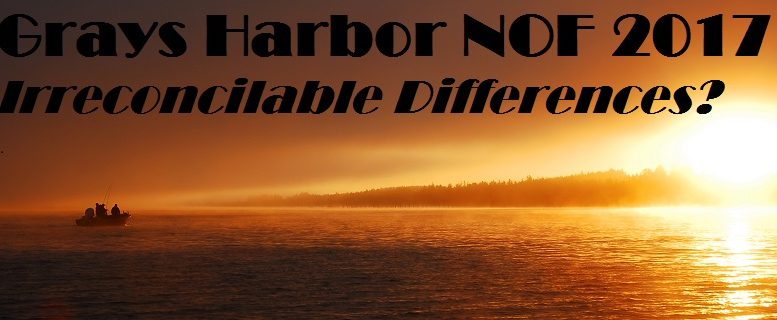Season-setting discussions for Grays Harbor salmon officially kicked off on February 22. The moment we’ve all been nervously waiting for delivered a mixed bag as the state officially released a portion of its preseason forecast (PSF) for the basin. A “portion” being the salmon stocks for which WDFW and the Quinault Indian Nation (QIN) have reached technical agreement.
Specifically, WDFW is forecasting a dismal return of 1,300 spring chinook (spawner goal = 1,400) and a healthy return of 30,100 chum (spawner goal = 21,000). The fall chinook and coho forecasts for the Chehalis and Humptulips sub-basins were left blank on the PowerPoint slide as the state and QIN have yet to come to technical agreement on the numbers. Grays Harbor lead biologist Mike Sharpf hinted that QIN agrees that the chinook number is low and PSF disparity is relatively small. However, the gap in the coho PSF is cavernous. QIN believes only 29K wild coho will return versus WDFW’s forecast of 109K… a 375% disparity!
As per the Grays Harbor Salmon Management Policy (GHSMP) “penalty box” clause, no directed fishery may take place for any natural-origin salmon stocks that have failed to achieve spawner objectives in 3 or more of the previous 5 years. We are squarely in the penalty box for wild Chehalis chinook and wild Humptulips coho for 2017, which means only a 5% incidental impact cap for each of these wild stocks will be allowed while prosecuting fisheries for other harvestable stocks in the basin.
Until the co-managers eventually agree upon the PSF’s for wild Chehalis coho and wild Humptulips chinook, a directed fishery on either stock remains uncertain. If these PSF’s come up short, the best we can hope for is a one fish bag on hatchery chinook or hatchery coho constrained by a 5% wild impact for their wild counterparts.
The GHSMP is the state’s conservation-minded blueprint to ensure our stocks are NOT overfished during times of reduced productivity… just like what the ocean is serving up right now. The tenets of the GHMP are biologically sound from a conservation perspective, and since the policy’s original implementation WDFW has amply demonstrated its commitment to keeping itself accountable to the document.
However, the GHSMP only applies to state-managed fisheries, and there’s been no buy-in to the plan as far as QIN is concerned. Whereas the constraints imposed by the GHSMP to conserve a depleted stock may render state fishers unable to fully access otherwise harvestable surpluses of other more plentiful stocks, the QIN does not hold itself accountable to the same constraints. Nor are they legally bound to do so.
Unfortunately, the two co-managers continue to have different ideas about how to forecast run-sizes, and widely disparate fishery objectives, particularly with regard to measuring spawner objectives. QIN measures chinook and coho spawner goals in the aggregate for the entire basin while WDFW manages the goals for Humptulips separately from those for Chehalis sub-basin. This has profound conservation implications for the success of weak-stock management.
Grays Harbor fisheries function much like a symphony with TWO conductors each reading from a different sheet of music. Imagine the difficulty and frustration as some of the musicians follow the lead of one conductor, while the rest follow the other. Each night when the curtain comes up, it’s anybody’s guess how well the concert will be performed. More often than not, it’s horribly painful to listen to.
Difficult and frustrating suitably describes this dysfunctional relationship in pre-season planning, especially when it results in the chronic inability to consistently meet escapement objectives post-season. Painful.
All of it makes one wonder just how much longer folks will keep buying tickets to the show?
To View the Grays Harbor salmon policy (C3621)in further detail, check out the link below:
http://wdfw.wa.gov/commission/policies/c3621.html


Be the first to comment on "Gray’s Harbor- Irreconcilable Differences?"